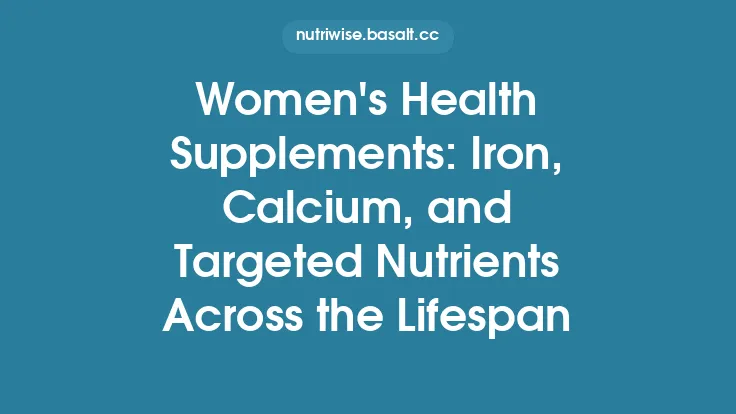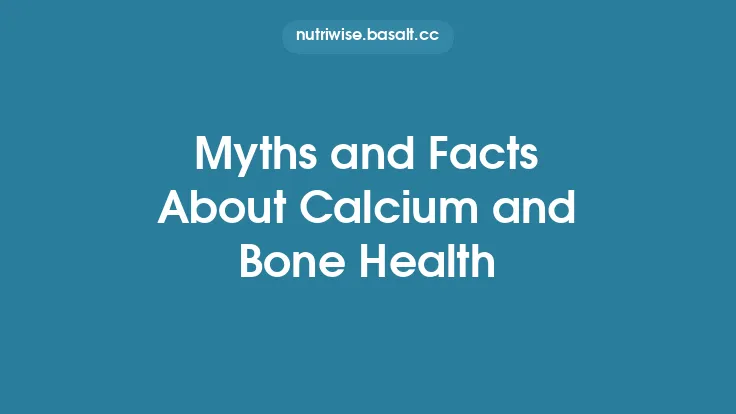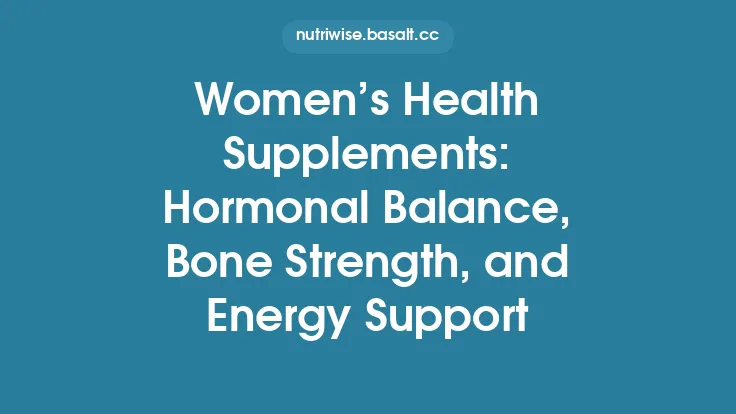Bone health is a lifelong priority that hinges on a delicate balance between bone formation and resorption. While genetics, physical activity, and overall nutrition lay the foundation, targeted supplementation can fill critical gaps, especially when dietary intake falls short or physiological demands increase. This article delves into the science behind the most studied bone‑supporting nutrients—calcium and vitamin D—while also exploring emerging compounds that show promise in enhancing skeletal strength and reducing fracture risk. By examining mechanisms of action, optimal dosing strategies, and safety considerations, readers will gain a comprehensive, evidence‑based roadmap for supporting bone health through supplementation.
Understanding Bone Remodeling
Bone is a dynamic tissue that undergoes continuous remodeling throughout life. Two primary cell types drive this process:
- Osteoblasts – responsible for bone formation by synthesizing collagen matrix and facilitating mineral deposition.
- Osteoclasts – mediate bone resorption, breaking down mineralized matrix to release calcium and phosphate into circulation.
The remodeling cycle is tightly regulated by hormonal signals (parathyroid hormone, calcitonin, estrogen, and vitamin D), mechanical loading, and local cytokines. An imbalance—where resorption outpaces formation—leads to net bone loss, manifesting as osteopenia or osteoporosis. Effective supplementation aims to tip the balance back toward formation or at least maintain equilibrium.
Calcium: The Cornerstone Mineral
Biological Role
Calcium accounts for roughly 99 % of the body’s mineral content, with the vast majority stored in bone as hydroxyapatite crystals (Ca₁₀(PO₄)₆(OH)₂). Beyond structural support, calcium is essential for:
- Muscle contraction
- Nerve impulse transmission
- Blood clotting
- Hormone secretion
Dietary Sources and Bioavailability
Typical dietary sources include dairy products, fortified plant milks, leafy greens, and certain fish (e.g., sardines with bones). However, bioavailability varies:
| Food Source | Approx. Calcium (mg/serving) | Estimated Absorption |
|---|---|---|
| Milk (1 cup) | 300 | 30–35 % |
| Yogurt (plain, 1 cup) | 400 | 30–35 % |
| Kale (cooked, 1 cup) | 180 | 20–30 % |
| Almonds (1 oz) | 75 | 5–10 % (due to oxalates) |
| Tofu (calcium‑set, ½ cup) | 250 | 30–40 % |
Oxalates and phytates can bind calcium, reducing absorption. Hence, supplement forms that minimize these inhibitors are often preferred for individuals with low dietary intake.
Supplement Forms
| Form | Calcium Content (mg) per tablet/capsule | Typical Absorption Rate |
|---|---|---|
| Calcium carbonate | 500–600 | 20–30 % (requires gastric acid) |
| Calcium citrate | 200–250 | 40–45 % (well absorbed even with reduced acid) |
| Calcium lactate | 150–200 | 30–35 % |
| Calcium gluconate | 90–100 | 20–25 % |
Calcium carbonate is the most economical but depends on adequate stomach acidity; it is best taken with meals. Calcium citrate, though more expensive, offers consistent absorption and is suitable for older adults or those on proton‑pump inhibitors.
Recommended Intake
The Institute of Medicine (now the National Academy of Medicine) recommends:
- Adults 19–50 yr: 1,000 mg/day
- Women >50 yr & men >70 yr: 1,200 mg/day
These values assume a mixed diet; supplementation should fill the gap between dietary intake and the target.
Vitamin D: The Master Regulator
Mechanistic Overview
Vitamin D exists in two major forms relevant to humans:
- Vitamin D₃ (cholecalciferol) – synthesized in skin upon UV‑B exposure or obtained from animal sources.
- Vitamin D₂ (ergocalciferol) – derived from plant sterols.
Both are converted in the liver to 25‑hydroxyvitamin D [25(OH)D], the primary circulating marker used to assess status. The kidneys further hydroxylate 25(OH)D to the active hormone 1,25‑dihydroxyvitamin D [1,25(OH)₂D], which binds the vitamin D receptor (VDR) in target cells, including osteoblasts and intestinal enterocytes.
Key actions for bone health:
- Enhances intestinal calcium absorption – upregulates TRPV6 and calbindin‑D₉k channels.
- Modulates osteoblast differentiation – promotes matrix mineralization.
- Regulates parathyroid hormone (PTH) – suppresses secondary hyperparathyroidism, reducing excessive bone resorption.
Serum 25(OH)D Targets
- Deficient: <20 ng/mL (50 nmol/L)
- Insufficient: 20–29 ng/mL (50–74 nmol/L)
- Sufficient: 30–50 ng/mL (75–125 nmol/L)
- Potentially optimal for bone health: 40–60 ng/mL (100–150 nmol/L)
These thresholds are based on the point at which calcium absorption plateaus and PTH levels stabilize.
Supplement Forms and Dosing
| Form | Typical Dose (IU) | Frequency | Notes |
|---|---|---|---|
| Vitamin D₃ (softgel) | 1,000–2,000 | Daily | Preferred for most adults |
| Vitamin D₃ (liquid) | 400–1,000 | Daily | Useful for children or those with swallowing difficulties |
| High‑dose D₃ (50,000 IU) | 50,000 | Weekly or monthly (prescribed) | For severe deficiency under medical supervision |
A general maintenance dose of 1,000–2,000 IU/day is safe for most adults and helps maintain serum 25(OH)D in the sufficient range. Higher doses may be needed in winter months, for individuals with limited sun exposure, higher body mass index, or malabsorption syndromes.
Emerging Nutrients for Bone Health
While calcium and vitamin D remain the pillars, research over the past decade has identified several additional nutrients that influence bone metabolism. Their mechanisms often intersect with the calcium‑vitamin D axis or act through independent pathways.
Magnesium
- Role: Cofactor for enzymes involved in vitamin D activation; contributes to hydroxyapatite crystal formation.
- Evidence: Meta‑analyses show that magnesium supplementation (300–500 mg/day) modestly improves bone mineral density (BMD) in postmenopausal women, especially when baseline intake is low.
- Sources: Nuts, seeds, whole grains, and supplements (magnesium citrate, glycinate).
Vitamin K₂ (Menaquinone)
- Forms: MK‑4 (short‑chain) and MK‑7 (long‑chain). MK‑7 has a longer half‑life, allowing once‑daily dosing.
- Mechanism: Activates osteocalcin, a protein that binds calcium to the bone matrix. Adequate vitamin K₂ ensures that calcium is deposited in bone rather than soft tissues.
- Clinical Data: Randomized trials report that 180 µg/day of MK‑7, combined with calcium and vitamin D, reduces bone loss and fracture risk in older adults.
- Food Sources: Natto, fermented cheeses, and certain animal livers.
Boron
- Function: Modulates the activity of enzymes involved in calcium and magnesium metabolism; influences estrogen and testosterone levels, which are bone‑protective.
- Research: Small trials suggest 3 mg/day of boron improves calcium and magnesium retention and may increase BMD in postmenopausal women.
- Intake: Typically 1–3 mg/day from diet (fruits, nuts, legumes).
Strontium (as Strontium Citrate)
- Action: Replaces calcium in the hydroxyapatite lattice, leading to a denser but slightly more brittle bone. It also stimulates osteoblast activity while inhibiting osteoclasts.
- Evidence: The FDA‑approved drug strontium ranelate (not available in the U.S.) demonstrated reduced fracture rates, but concerns about cardiovascular risk limit its use. Low‑dose dietary strontium (≈300 mg/day) may still confer modest benefits without significant adverse effects.
- Caution: Excessive strontium can interfere with calcium homeostasis; supplementation should be monitored.
Omega‑3 Fatty Acids (EPA/DHA)
- Relevance: Anti‑inflammatory properties reduce cytokine‑mediated bone resorption. Some cohort studies link higher EPA/DHA intake with higher BMD.
- Dosage: 1,000–2,000 mg/day of combined EPA/DHA is commonly used for cardiovascular health and may provide ancillary bone benefits.
Collagen Peptides
- Mechanism: Provide glycine, proline, and hydroxyproline—amino acids essential for collagen synthesis, the primary organic component of bone matrix.
- Findings: Randomized trials in postmenopausal women show that 10 g/day of hydrolyzed collagen improves BMD and reduces bone turnover markers when combined with calcium and vitamin D.
Synergy and Timing: Optimizing Supplement Absorption
Calcium and Vitamin D Co‑Administration
- Rationale: Vitamin D enhances calcium absorption; taking them together maximizes the net calcium retained.
- Practical Tip: A calcium‑vitamin D combination tablet (e.g., 500 mg calcium carbonate + 800 IU vitamin D₃) taken with a main meal ensures adequate gastric acid for carbonate dissolution and provides dietary fat for vitamin D absorption.
Magnesium Interaction
- Consideration: High calcium doses can compete with magnesium for intestinal transporters. A balanced calcium‑magnesium ratio (approximately 2:1) is advisable.
- Timing: Split calcium (e.g., 500 mg twice daily) and magnesium (e.g., 250 mg at bedtime) to avoid competition.
Vitamin K₂ Scheduling
- Guideline: Take vitamin K₂ with the same meal as calcium and vitamin D to facilitate osteocalcin activation.
- Safety Note: Individuals on anticoagulant therapy (warfarin) should consult a physician before adding vitamin K₂.
Avoiding Interference from Certain Medications
- Thyroid Hormone (Levothyroxine): Calcium carbonate can bind levothyroxine, reducing its efficacy. Separate dosing by at least 4 hours.
- Bisphosphonates: Calcium supplements should be taken at least 30 minutes after bisphosphonate administration to prevent chelation.
Safety, Dosage, and Interactions
| Nutrient | Upper Safe Limit (UL) | Common Adverse Effects | Key Interactions |
|---|---|---|---|
| Calcium | 2,500 mg/day (19–50 yr) / 2,000 mg/day (>50 yr) | Hypercalcemia, kidney stones | Iron, zinc, magnesium (absorption competition) |
| Vitamin D | 4,000 IU/day (adults) | Hypercalcemia, vascular calcification (rare) | Thiazide diuretics (increase calcium) |
| Magnesium | 350 mg/day (supplemental) | Diarrhea, abdominal cramping | Certain antibiotics (tetracyclines) |
| Vitamin K₂ | No established UL; doses up to 1 mg/day well tolerated | Rare allergic reactions | Anticoagulants (warfarin) |
| Boron | 20 mg/day | Nausea, skin irritation | None significant at typical doses |
| Strontium | 1,000 mg/day (dietary) | Potential cardiovascular risk at high doses | Calcium (competition) |
Individuals with chronic kidney disease, hyperparathyroidism, or sarcoidosis should seek medical guidance before initiating high‑dose calcium or vitamin D.
Practical Recommendations for Different Life Stages
Adolescents (12–18 yr)
- Goal: Achieve peak bone mass.
- Suggested regimen: 1,300 mg calcium + 600–800 IU vitamin D daily; consider a magnesium supplement (250 mg) if dietary intake is low. Encourage weight‑bearing exercise.
Young Adults (19–30 yr)
- Goal: Maintain bone density while supporting active lifestyles.
- Regimen: 1,000 mg calcium + 800–1,000 IU vitamin D; optional vitamin K₂ (90–120 µg MK‑7) for those with low intake of fermented foods.
Perimenopausal Women (45–55 yr)
- Goal: Counteract estrogen‑related bone loss.
- Regimen: 1,200 mg calcium + 1,000–2,000 IU vitamin D; add vitamin K₂ (180 µg MK‑7) and magnesium (300 mg) to support remodeling. Consider collagen peptides (10 g) if dietary protein is insufficient.
Postmenopausal Women & Older Men (>65 yr)
- Goal: Preserve BMD and reduce fracture risk.
- Regimen: 1,200 mg calcium (split doses) + 2,000 IU vitamin D; magnesium 300–400 mg; vitamin K₂ 180 µg; optional boron 3 mg. Evaluate need for prescription osteoporosis therapy in conjunction with supplements.
Athletes & High‑Impact Individuals
- Goal: Support bone turnover from repetitive loading.
- Regimen: Similar to young adults but emphasize timing (calcium with meals, magnesium at night) and ensure adequate protein (≥1.2 g/kg body weight) to supply collagen precursors.
Future Directions in Bone Health Supplementation
- Personalized Nutrition: Genomic markers (e.g., VDR polymorphisms, CYP2R1 variants) may predict individual responsiveness to vitamin D dosing, paving the way for tailored supplement plans.
- Nanoparticle Delivery Systems: Encapsulation of calcium and vitamin D in liposomal or polymeric nanoparticles aims to improve intestinal uptake and reduce gastrointestinal side effects.
- Synergistic Formulations: Ongoing trials are testing combined calcium‑vitamin D‑K₂‑magnesium “bone‑complex” capsules that mimic the natural mineral matrix, potentially offering superior BMD outcomes.
- Microbiome‑Mediated Effects: Emerging evidence suggests gut bacteria influence calcium absorption and vitamin D metabolism; prebiotic fibers may become adjuncts to traditional bone supplements.
Bottom Line
A robust bone health strategy integrates adequate dietary intake, targeted supplementation, and lifestyle factors such as weight‑bearing exercise and sun exposure. Calcium and vitamin D remain the foundational nutrients, but emerging players—magnesium, vitamin K₂, boron, strontium, omega‑3s, and collagen peptides—offer additional avenues to strengthen the skeletal system. By understanding each nutrient’s mechanism, optimal dosing, and potential interactions, individuals can craft a safe, effective supplement regimen that supports lifelong bone integrity.





